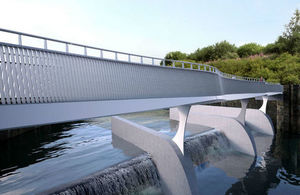Knostrop footbridge starts to take shape over the River Aire
Mobile crane will lift in the decks this week

An artist's impression of the footbridge
The main structure of a new footbridge over the River Aire is making progress as a mobile crane lifts in the decks of the bridge section later this week.
The footbridge, part of the Leeds Flood Alleviation Scheme, is being constructed over the moveable weirs that are already in position at Knostrop.
The four bridge sections, are due to be installed this week and will be lifted into place by a 500 tonne crane. Once these are in place there will be 4 weeks of finishing work. The new bridge structure will weigh approximately 150 tonnes and span approximately 70 metres. Designed by Knight Architects, the bridge has a sinuous form to reflect the movement of water over the new Knostrop Weir. It has been positioned to provide dramatic views of the weir in operation. The very narrow piers and curving underside of the bridge deck are designed to give the bridge a slender appearance when viewed from up or downstream.
The new footbridge is being installed to reconnect the much-used Trans Pennine Trail, following the removal of a section of island between the River Aire and Aire and Calder Navigation for flood risk reduction purposes.
Construction of the new Trans Pennine Trail along the north bank of the river will begin once the bridge has been installed. The new route of the Trans Pennine Trail will be opened on completion of the project in September.
Leader of Leeds City Council Councillor Judith Blake said:
It is very pleasing to see the new Knostrop footbridge being installed as part of the final touches of the first phase of the Leeds Flood Alleviation Scheme.
The bridge design is very attractive and striking, and will offer some fantastic views over the River Aire and of the new moveable weirs which I’m sure people will be keen to come and see for themselves.
Aside from the reassurance this scheme will offer to residents and businesses against the risk of flooding, it also brings important leisure and environmental benefits due to the views of the river as well as reconnecting the improved Trans Pennine Trail, offering the chance to see otters, salmon and other wildlife making the most of the improving water quality and access down river open for the first time in over 200 years.
At Knostrop, all three moveable weirs are now complete and fully operational. Similar weirs are also being constructed upstream at Crown Point as part of phase 1 of the Leeds Flood Alleviation Scheme.
Fish passes have been constructed on the new weirs at Knostrop and Crown Point, to help fish overcome these barriers and migrate upstream and further increase populations of species such as salmon.
The most obvious indictor of whether the fish passes are successful will be the sightings of salmon upstream of the weirs. Routine fish surveys will also be carried out by the Environment Agency to see any patterns in fish populations although there have already been sightings by angling enthusiasts of salmon through the city centre for the first time in over 200 years.
Rare and protected species, including otters, are now found in the River Aire catchment. This is a good indicator of improving water quality, following a history of heavy industry which depleted many species. Otters exist in a small but increasing population, and because of great improvement in water quality have been spotted in the city centre. An otter ramp has been installed at Knostrop to help them move up over the weir and otter holts will be built to help further encourage numbers.
The Leeds Flood Alleviation Scheme is led by Leeds City Council in partnership with the Environment Agency and is split into two phases.
Phase 1 began in January 2015, and costing in the region of £50million, is one of the largest river flood defence schemes in the country. The scheme is putting in place formal flood defences along the River Aire for the first time. It has already seen works completed downstream in Woodlesford, and the city centre element which features the introduction of state-of-the-art moveable weirs at Crown Point and Knostrop is due to be completed this September. When finished, phase one of the scheme will indirectly safeguard 22,000 jobs and improve resilience for 3,000 homes and 500 businesses.